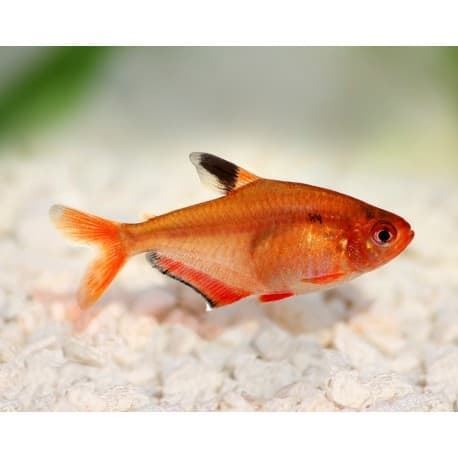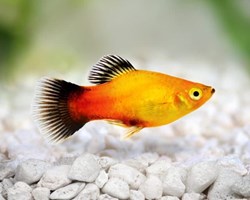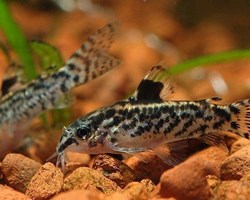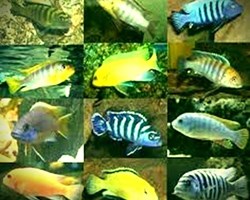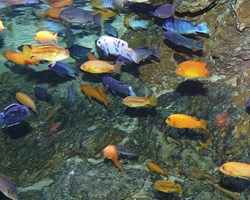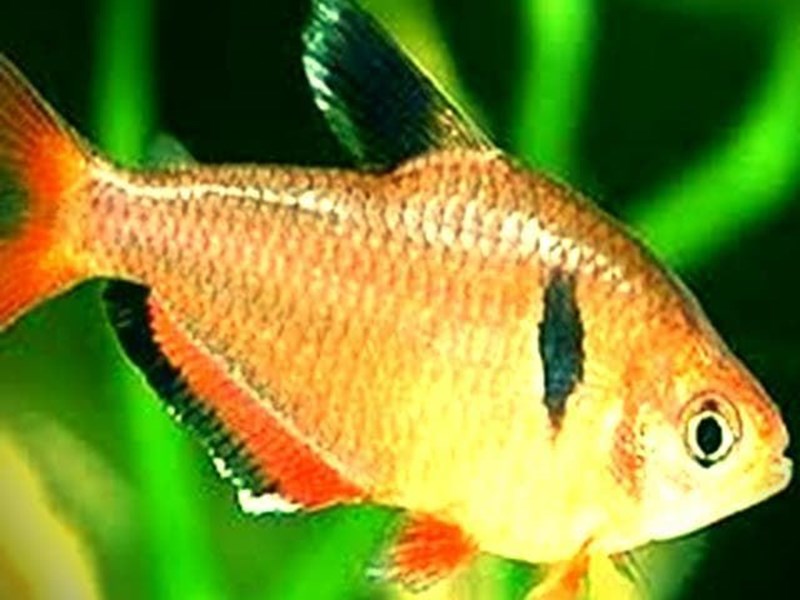
INDEX:
1.- DESCRIPTION.
2.- HABITAT.
3.- CARE OF THE AQUARIUM.
4.- BEHAVIOR AND COMPATIBILITY.
5.- NUTRITION OF THE TETRA SERPA.
6.- REPRODUCTION OF THE TETRA SERPA.
1.- DESCRIPTION:
The scientific denomination is Hyphessobrycon eques (Steindachner, 1882).
We are dealing with a typical characin (family Characidae) in whose genus Hyphessobrycon more than 100 species of tetra fish are cataloged that come from the so-called neotropics or tropical ecozone.
The vast majority of these fish are found in the rivers of South America.
In the genus Hyphessobrycon, a consensus has not always been reached on the classification of the different species that compose it.
It is accepted that some characteristics that define it are the typical adipose fin of the characins, two series of teeth in the premaxilla with the outermost teeth distributed in a simple series, and an incomplete lateral line.
The species Hyphessobrycon eques has also been known by various scientific names such as Tetragonopterus callistus, Hemigrammus serpae, or Hemigrammus melanopterus.
The variety of common names is due to their coloration: serpae tetra, fire blood tetra, jewel tetra and red tetra.
The tetra serpae receives a variety of names that are related to its beautiful color.
The species stands out among other tetras for the intensity and contrast of its colors.
It is a fish with an elongated and laterally compressed body, like all of the Characidae family.
It has a red coloration that in the male can be very intense, particularly during the mating season.
The belly is orange or reddish depending on its mood or the quality of the water.
On the sides it has a black spot that looks like a diamond, one of the differences it has with respect to Megalamphodus sweglesi (red ghost tetra), which are very similar, but in the case of the latter, the black spot is oval.
It also has a black spot on the dorsal and anal fins.
The black diamond-shaped spot behind the opercula that distinguishes the male is usually absent, or inconspicuous, in captive-bred specimens.
Sexual differentiation is usually well defined not only by coloration, more intense in the male, but also by the size and shape of the fins.
The male has a more black pigmented dorsal fin while the female has no black coloration at the base of said fin.
In captivity and with the right conditions for its maintenance, it can live up to 5 years and even exceed them. They can live 6 to 7 years.
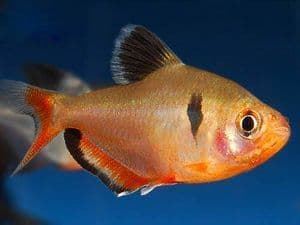
2.- HABITAT:
It is found naturally in South America, specifically from the Amazon to Paraná, at the height of San Pedro (Buenos Aires Province), including Paraguay, Bolivia and the Pantanal area of Mato Grosso.
On the Argentine side it is found along the Paraguay and Paraná, Pilcomayo, Bermejo rivers and streams and tributary rivers. It abounds in shaded areas and with abundant aquatic plants.
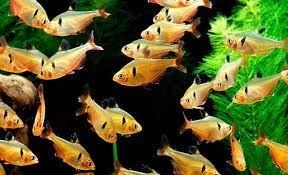
3.- CARE OF THE AQUARIUM:
It is a species that likes to swim in schools, suitable for community aquariums.
The minimum to provide it with adequate conditions is in an urn with a length of 60 cm.
It prefers soft water (dH 5-8), and slightly acidic (pH 6.7).
As for the temperature of the water, it should be kept between 24-25ºC.
The tetra serpa is a typical species of an Amazon style aquarium, it needs free spaces so that it can swim but with plants around them.
The lighting should not be excessive.
In addition, providing a habitat with plants, some floating that dim the intensity of light, and places to hide, will end up providing the protection it requires and thus avoid aggressive behavior towards other fish.
Rocks can be used to decorate the aquarium they live in.
It is a very lively fish to keep in schools in planted aquariums.
Nothing being seen between the middle zone and the surface of the aquarium.
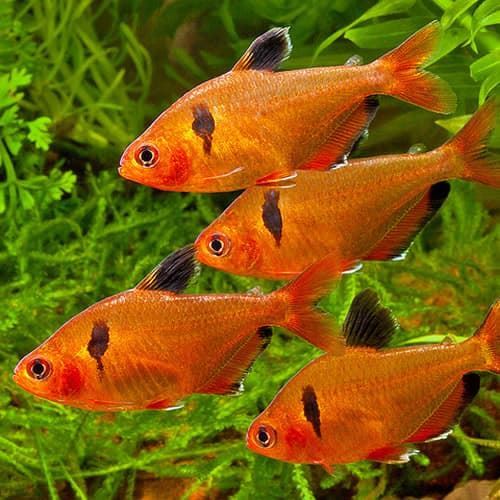
4.- BEHAVIOR AND COMPATIBILITY:
The importance of properly differentiating it from other species of the same family must be pointed out, since its behavior is not necessarily peaceful, as one would expect from most tetras.
Its character is described as moderate aggressiveness and with a clear tendency to peck the fins of other specimens of the same species, or of any other aquarium fish with delicate fins.
It definitely may not be a good tank mate for smaller guppies or tetras, and this behavior has also been known towards even larger fish like betta splendens or gouramis.
They are very lively swimmers that will quickly ingest food and have a tendency to bite the fins between members of their own school.
A school with a greater number of members is recommended as long as the volume of the aquarium allows it.
If we have doubts to make it compatible with other fish, it would be best to decide on quieter species of tetras.
Like all tetras it is an easy maintenance fish, affordable for all levels.
But it is accompanied by a negative fame acquired by nibbling the fins of other fish.
Its aggressive behavior must be alleviated by maintaining a school with a number of specimens adequate for the size of the aquarium.
For an urn with a minimum estimated length of 60 cm, half a dozen serpae tetras should be considered, recommending expanding the group if we have a larger volume in our aquariums.
They are gregarious fish to which the group will give them security by mitigating aggressive behavior.
For this, it is also recommended proportional hiding places in rocks or caves, and fundamentally an aquarium overflowing with plants.
They respond well in aquariums with spaces to hide between rocks and plants, which can be floating or tall plants that help them feel confident with their habit of swimming in the middle or upper zone of the aquarium, in nature they enjoy being close to the surface surrounded by plant stems.
The species prefers low light intensity, floating plants will help us dim the light in certain areas of the aquarium.
If you have few tetra serpae or the aquarium does not provide the necessary security, you should avoid mixing them with smaller tetras and any type of species that has delicate tails: bettas, gouramis, guppies, etc.
Nor should we forget that it is still a tetra, so it is recommended not to combine it with aggressive or very large species that would endanger the tranquility of the school.
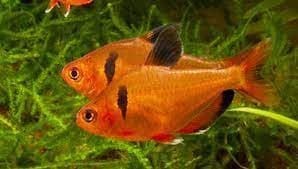
5.- SERPA TETRA NUTRITION:
In nature it is an omnivore that eats insects, crustaceans and plants.
Likes live food, flakes or frozen food.
It will accept any commercial preparation that suits its size.
A rich and varied diet helps to highlight its color.
When it comes to feeding it, it shows its greatest display of aggressiveness with rapid movements and being able to peck at each other.
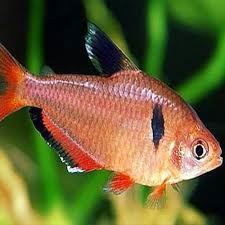
6.- REPRODUCTION OF THE TETRA SERPA:
One of the attractions for the aquarium hobbyist is that the tetra serpae is one of the easiest tetra species to breed in captivity.
You have to use small aquariums of 12 -18 liters, with black substrate and plants such as cabombas, myriophyllum or java moss.
Water with a sensitive acidity (between 6 and 7 ph), and hardness between (4 and 8 dH).
When the eggs are fertilized, the parents must be removed to prevent them from being eaten.
Hatching occurs in 24-28 hours.
Reproduction is simple, pairs are formed randomly for each set.
As in other fish of the families that spawn in schools, during spawning the male vigorously pushes the female.
Courtship is inconspicuous, and after a few chases and pushes the female will scatter the eggs around the tank and plants.
The number of eggs can reach 400-450 depending on the age, maturity and previous feeding of the parents.
The eggs hatch (at 25º C) within 24-30 hours.
The fry immediately swim in search of food.
In captivity, feeding will be regulated according to the breeder's criteria.
Live feeding is essential at this stage.
